Covid-19 sounds like a futuristic thriller in its own right but, sadly, it’s not: it’s real, and unfortunately we continue to live through it. On one of the very few plus sides, at least lockdown has given us plenty of movie time, allowing for catching up on golden oldies and discovering new gems.
Our new series of Roundtable Flashbacks aims to revisit the past and mark the 20 and 25 year anniversaries of animated films you may have missed the first time around — or simply haven’t seen in a while!
First up, AV’s Ben, Dacey, Dan, James and Rand literally “launch” this series in style, gathering virtually for Don Bluth and Gary Goldman’s surprise sci-fi outing — and still currently their final film — the epic Fox Animation space adventure Titan A.E., this year turning an incredible twenty years old!

Ben: So, Titan A.E.! We all watched it. What did we think? Should we start with a little bit of history?
Dacey: Probably, yeah.
Ben: Well, I went to Fox back in 1997 or 98, and they were only just working on this thing, and back then it was called Planet Ice. I’m not even sure Don Bluth was on it; they had all of this artwork up, and this was under Art Vitello, I believe, and this was going to be their big thing, Planet Ice. Of course then it gets confusing because Planet Ice was also the working title for James Cameron’s Titanic, so someone at Fox really liked that title! But then I didn’t hear anything about it again until I was on location on a different show, and we were in the middle of nowhere in the north of England, and the only thing we could do every night was either go to the Chinese restaurant or to the movie theater. And on one of the nights we saw that the new Don Bluth film was playing, so we went to see it, and I was kind of blown away the first time I saw it. In prep for this, I found an article from one of the animation magazines at the time that was saying how this was the first digital film that was beamed to the theater over ADSL lines. They had this premiere in Atlanta, and then another one in London, or somewhere in Europe — it may have been Annecy — and they beamed it over the internet and showed it digitally. It never touched film. So it’s really annoying now that, for a digital film like that, it’s crazy we can’t get it on Blu-ray, and it’s not even on Disney+!
Dan: Yeah. I mean they just put the most recent Fantastic Four movie on Disney+, so I’m assuming they’re getting there — slowly!
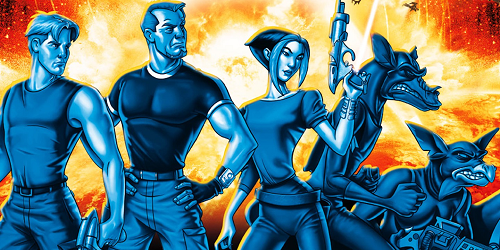 Ben: But I thought the DVD — we ran it down here in our theater — really held up well. It didn’t look blurry or anything, it was a really good, solid transfer, I thought, for standard def DVD.
Ben: But I thought the DVD — we ran it down here in our theater — really held up well. It didn’t look blurry or anything, it was a really good, solid transfer, I thought, for standard def DVD.
Dan: Yeah, I’m seeing that right now. I have it running on my TV in front of me at the moment, and it’s at the scene where Cale is about to escape the Drej. And, yeah, for standard definition, it still looks pretty good, all things considered.
Ben: Absolutely. I wonder how Don Bluth feels about his big Fox features now being owned by Disney. You know, he gets away from that studio, and he makes these big films, and then, “Oh, the Mouse still wins!”
Dan: I did see in a picture that he was there at Disney not too long ago, maybe a couple of years ago, so I guess things are slowly beginning to heal maybe?
Ben: I understand that every three or four years they try and invite him back, and he keeps saying no. And now I wonder how they feel, or if they’re even positive about owning Anastasia, because it’s kind of odd that — given the audience love for that film — they’ve got all the other family Fox titles like Fantastic Four, Home Alone, Ice Age… and Anastasia is still not on Disney+, even though it’s the most “Disney” of the Fox films. And who knows what that means for Titan A.E.! But going back to the DVD quick, I will say, and I don’t know what kind of sound systems you guys have, but I thought the DTS track on this was awesome!
Rand: It’s pretty good, yeah. You know, before Blu-ray, I was using Titan A.E. as my demo disc when people would come over, because it puts out quite a bit of base and sounds really good.
Ben: Yeah. Did you just say Blu-ray!?
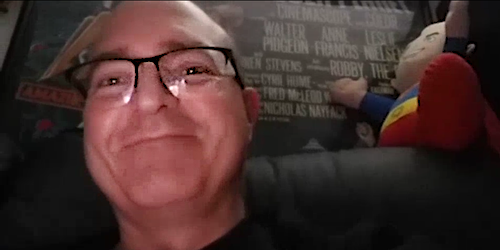 Rand: Before I had Blu-ray…
Rand: Before I had Blu-ray…
Ben: Oh, before you had Blu-ray! Okay. I was about to seriously get on your back for not telling us you had a Titan A.E. Blu-ray. (laughter)
Dan: (laughing) Yeah, really!
Ben: Yeah, Dan and I, we’re going up to Canada and get his Blu-ray off him!
Rand: (laughing)
Dacey: I’m not sure if it’s a 4K transfer, but it is available on YouTube as a rental.
Ben: Oh, yeah, it would look awesome in 4K.
Rand: I tried watching it on Netflix just to see what the HD would look like, but it’s off of Netflix now.
Ben: I was gonna ask if anybody has seen it in HD? It must have been shown on one of the networks in HD somewhere? But you know what was odd, which I have never noticed before, but on a bigger screen, it’s a film transfer. It’s not even a digitial transfer. It’s off film.
Dan: Like something I noticed almost immediately, as soon as the movie started, was like, “hmmmm, this ain’t digital”.
Ben: Yeah, I there’s a little spec on the Fox logo. And you’re kind of like, “Okay, wasn’t expecting that”.
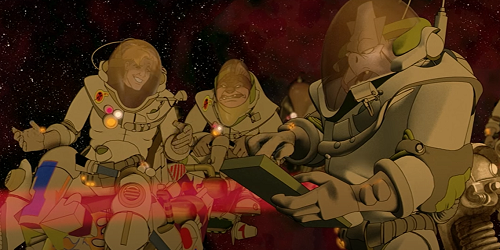 Dan: At first I was trying to figure it out, like maybe I was misremembering correctly and they did some sort of weird filter effect for the logo when it first played? But, then I realised, no, it’s film.
Dan: At first I was trying to figure it out, like maybe I was misremembering correctly and they did some sort of weird filter effect for the logo when it first played? But, then I realised, no, it’s film.
Ben: You know, one thing I did notice was how rock steady it was, even though it was a print and not a digital file, but it was rock steady. Such a good transfer. If it is film, then they could maybe go back to that negative and do a pretty good 4K transfer. And it’s a shame because, just before Disney came along, Fox had a really good 4K program going. They’re bringing out, you know, Die Hard and Predator and all these films in really nice updates, and it would’ve been really nice if they had gotten to Titan A.E. Maybe as number 1,946 on that list!
Dan: Yeah, that’s real low, I would imagine.
James: There’s Fox titles on Disney Movie Club this month, so maybe it will get a Movie Club Exclusive?
Ben: We can hope. Maybe if all five of us wrote to them…
James: They have Ferdinand this month, so maybe someday.
Dan: They’re probably doing Blue Sky first before touching any other animation under their Fox catalog. Maybe we should let them know Blue Sky DID have some work on Titan A.E.!
Ben: Well, one shot. It’s quite a good shot, though! So, as for the rest of Titan — this film, for me, I call it “Non Bluth”.
Dacey: Yeah. “Non Bluth”…
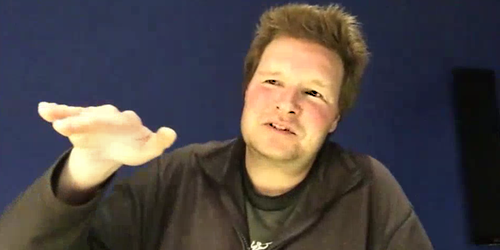 Ben: It’s totally not his usual kind of thing. And from what I understand — I had a quick squiz through some of the commentary — and from what I understand, obviously it was someone else’s film back when it was Planet Ice, and then I think he kinda got forced to do it. It was either take this, or Fox Animation closes. So I think he was kind of forced to take it on.
Ben: It’s totally not his usual kind of thing. And from what I understand — I had a quick squiz through some of the commentary — and from what I understand, obviously it was someone else’s film back when it was Planet Ice, and then I think he kinda got forced to do it. It was either take this, or Fox Animation closes. So I think he was kind of forced to take it on.
Dacey: I think on the commentary he says he was brought on very late, considering when the movie came to theaters. He mentions he and Gary Goldman were brought on right after they finished production on the direct-to-video movie Bartok The Magnificent, so that was either ’98 or early 1999. Titan comes out June 2000, and Fox was committed to that date, so they did all of the animation over a crazy course of 13 months, or 18 months, which is absolutely nuts for a movie of this scale, especially in hand-drawn animation, which is so much more time-consuming than CGI.
Dan: Well, they did throw them a small bone, in that they expanded the production time to 19 months.
Ben: Yeah, you’re coming on late. You can have another three or four months! Actually, that timing rings true, because we were there, I’m trying to remember, the February of ’98 when I was there, and they weren’t on it yet. That was still when it was Planet Ice.
Dacey: Had Anastasia come out yet? I think it had.
Dan: Anastasia was out by the end of ’97.
Ben: Yeah, Anastasia was just out when we were out there. They were very proud of that, like ‘check out our big new film’, so we saw a screening of that. Obviously, Bluth had done Space Ace, but that was still kind of a cartoon — well, it was a video game — but it was still more of a cartoon style. But what I really like about this is it’s got that kind of Johnny Quest thing going for it, especially in the opening. It’s just like the dad could almost be out of Johnny Quest or something like that, you know? Just that whole feeling of the opening when earth is being evacuated. When Cale comes on, does anybody else think of Cody?
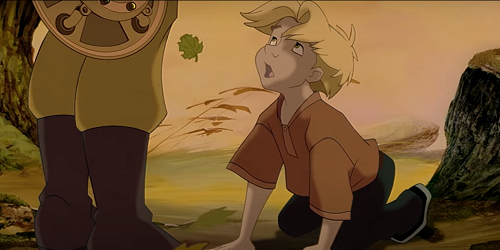 Dacey: Yes!
Dacey: Yes!
Dan: Yeah!
Ben: As we ran it and he came on, and I’d forgotten the beginning, I’m thinking, “it’s Cody!”
Dacey: On the commentary, Don Bluth says something like he hates how “cartoony” the boy looks compared to the other human characters in the movie, but again, the production was so rushed on this that they didn’t have time to make that change to Bluth’s satisfaction.
Ben: But you can still see the Bluth look; I mean, they always have that same jawline, and around the eyes as well. The lines around the eyes. So you still see that kind of Bluth design. Anybody else not find the grown-up Cale very sympathetic?
Dan: I think, because of the short run time being at 90 minutes, you don’t get to fully become sympathetic to his plight between when he’s separated from his dad to when he comes to the present. It’s just quick-bang and it’s already into his case, so you don’t really get a better feel for his character development leading up to that. The only certain sense you get of Cale regaining his sense of childhood is when he and Akima are stranded in New Bangkok. It’s funny, because that scene is coming up right now on my screen!
 Ben: You must be near the 52-minute mark. Did you catch the Death Star? You have to watch for the Death Star around that point. It’s part of the scenery there. I was kind of really interested in the way Matt Damon was playing it, when you first see Cale as an adult. He’s obviously not a natural animation actor, because he seems to be kind of projecting “seriousness” through his voice. He’s like (deepens voice to imitate Matt Damon) ‘If I do this really low, I’ll get really into it’. It just sounds like he’s really trying to “act” through his voice. I mean, especially in the first few scenes, he’s kind of a bit too serious. You know, get over yourself, Cale. Just lighten up a bit!
Ben: You must be near the 52-minute mark. Did you catch the Death Star? You have to watch for the Death Star around that point. It’s part of the scenery there. I was kind of really interested in the way Matt Damon was playing it, when you first see Cale as an adult. He’s obviously not a natural animation actor, because he seems to be kind of projecting “seriousness” through his voice. He’s like (deepens voice to imitate Matt Damon) ‘If I do this really low, I’ll get really into it’. It just sounds like he’s really trying to “act” through his voice. I mean, especially in the first few scenes, he’s kind of a bit too serious. You know, get over yourself, Cale. Just lighten up a bit!
Dan: Well, by that point, he was turning into a hot commodity. You know, just years after The Rainmaker and Good Will Hunting, and obviously Saving Private Ryan. So this opportunity to use someone who is just emerging comes into play, and this is his first foray into animation, so it’s like them trying to get him to say ‘you don’t have to project yourself this way’, you can do it this way, and have him go through multiple takes. I’m sure it was new to him even though he’s been in the business for a while, so just trying to get him to do this, I would imagine, is why it’s not so seamless between his acting from the beginning to towards the end. It kind of comes out that way.
Dacey: Well I think one thing that might be contributing to what you guys are saying — and I’m not saying I agree with that, because I don’t exactly — but something contributing to this is that so much of the animation, of Cale in particular, was very much done from live-action reference. Again, because of the insane production time, they did live-action reference for everything on this film, which is odd for animation today I think. One of the featurettes on the DVD gets into that. It’s almost rotoscoping, but not quite that, I think?
 Dan: Oh there’s definitively rotoscoping.
Dan: Oh there’s definitively rotoscoping.
Dacey: I don’t think they get quite the same facial animation out of some of the characters that they normally would because of that, at least on Cale, again, because of the rushed production time. So it’s slightly stiff — I don’t want to use that word, but it’s the word I’m using right now for some of it at least — especially when he’s a bit more of an edgy character, before he softens up during the second half of the film.
James: I found it distracting how much he looked like Matt Damon. Really, every time I looked at him, there’s Matt Damon’s face again, like someone just traced over a photo of him and added a perpetual smirk rather than bothering to animate any other emotions most of the time. I guess they did it because they didn’t have that much time to design a new character, so “let’s just make him look like the guy talking”, but I didn’t like it.
Ben: I thought he looked like John Smith.
Dan (laughing): I agree with you there! But yeah, to me it just seemed that because of the rushed production time, I could sense that they had no choice but to do rotoscoping on a lot of scenes. And it seemed very apparent to me on a great deal of them, because how rushed, given what little time thay had, in order to get this out in 19 months.
Ben: But that is also a Don Bluth trait. For Anastasia, there were reels and reels of live-action footage, and basically on that show they wore costumes which were black and white costumes so that the black lines would show through the paper and they could literally just rotoscope them. I think it’s a shame because it really shows, especially when you compare it to the Disney stuff at the time, which used live-action reference, whereas Bluth was doing straight line rotoscoping over the live-action footage. And it really shows, especially on Bill Pullman’s character as well, there’s a lot going on there with rotoscoping with him.
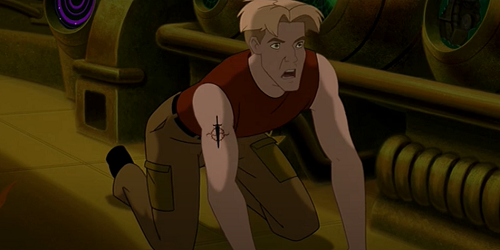 And then the weirdest thing, and I couldn’t work out how else they would do this, but the weird tattoo thing that Cale has on his arm? That doesn’t really sit on his arm properly? It’s a floaty kind of thing. Why wouldn’t you just draw that, or have it be something more simple? All the way through, and I was thinking this even when I saw it 20 years ago, I kind of thought that was going to come into play, that he was going to have to use that tattoo in some way, that it was going to be like some magic mark, you know? The whole film, you’re like, ‘why do you have this such awfully done tattoo on your arm that doesn’t really mean anything?’ What did you guys think of the tattoo?
And then the weirdest thing, and I couldn’t work out how else they would do this, but the weird tattoo thing that Cale has on his arm? That doesn’t really sit on his arm properly? It’s a floaty kind of thing. Why wouldn’t you just draw that, or have it be something more simple? All the way through, and I was thinking this even when I saw it 20 years ago, I kind of thought that was going to come into play, that he was going to have to use that tattoo in some way, that it was going to be like some magic mark, you know? The whole film, you’re like, ‘why do you have this such awfully done tattoo on your arm that doesn’t really mean anything?’ What did you guys think of the tattoo?
Dacey: I’m gonna say that was probably marketing, because Fox was experimenting in trying to make an animated movie very much directly aimed at teenagers who grew up in the ’90s who had made all of those Disney movies into massive hits, and now here’s this movie aimed at pleasing them now that they’re older. I’m going to guess things like the tattoo were placed on Cale’s arm simply for the sake of so-called appeal to that demographic.
Dan: That would definitely explain the music!
Ben: Well, you’re raising a really good point there, and I wonder if the tattoo was added really late? I wonder if they ever drew that, you know, knowing there was going to be a tattoo there, because it’s so weirdly placed on his arm all the way through.
Dan: I wouldn’t put it past them, especially given that towards the end of production, it was very apparent to me, from what I’ve read up, that 20th Century Fox just threw in the towel on the film a year into production. So by that point they’d laid off two thirds of the studio’s staff, and they’d outsourced the scenes to other people. So I imagine they outsourced this tattoo to another studio out there.
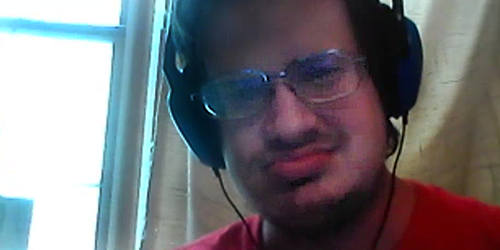 Dacey: Well originally it was all going to be computer animated as a fully CGI film. And then I don’t think they had the capability to do that with human characters. This was before The Incredibles, of course. Back then the only prominent human characters in a computer animated movie had been Andy and Sid in Toy Story. So I don’t think the studio was confident in being able to do human characters for a feature film, which is why I think — I could be wrong about this — the movie switched to traditional animation when Don Bluth was brought on board. I’m going to guess that’s when that happened. But back when it was called Planet Ice it was going to be an all computer animated film. For I know, they might’ve been wanting to go with something like Final Fantasy did the following summer with more “realistic” humans, and that film didn’t fare well either financially. I will add, though, that Titan A.E. is certainly a much better film than the Final Fantasy movie, but that’s another conversation for another time!
Dacey: Well originally it was all going to be computer animated as a fully CGI film. And then I don’t think they had the capability to do that with human characters. This was before The Incredibles, of course. Back then the only prominent human characters in a computer animated movie had been Andy and Sid in Toy Story. So I don’t think the studio was confident in being able to do human characters for a feature film, which is why I think — I could be wrong about this — the movie switched to traditional animation when Don Bluth was brought on board. I’m going to guess that’s when that happened. But back when it was called Planet Ice it was going to be an all computer animated film. For I know, they might’ve been wanting to go with something like Final Fantasy did the following summer with more “realistic” humans, and that film didn’t fare well either financially. I will add, though, that Titan A.E. is certainly a much better film than the Final Fantasy movie, but that’s another conversation for another time!
Ben: I thought Final Fantasy was brilliant — for one shot! And it’s not the one you think! It’s where — what’s the girl’s name? Aki Ross? — there’s one shot, literally, it’s a shot behind her, and she steps through a door. And that blew my mind. It’s just one simple shot, but it’s so good, where she just walks through this door. Very well done. And that was the best thing in that whole movie!
 Dan: It’s kind of interesting because Titan A.E., that had to go through an over abundance of rotoscoping because of the production time, and then we’re bringing up Final Fantasy which was, at the time, trying to develop and push what would eventually become motion-capture. It seemed like if they had maybe just continued to tinker and fine tune it a little more, and spend a couple of more years to do it, then maybe they would’ve had something on their hands, because eventually the video games took motion-capture to the next level. But at the time a lot of people were just put off by the extreme uncanny valley when you’re watching that film. And here we have Titan A.E. trying to combine traditional animation and CG animation together, and the rushed production time forces them to have to do rotoscoping on these characters against what would otherwise be very spectacular CG sequences.
Dan: It’s kind of interesting because Titan A.E., that had to go through an over abundance of rotoscoping because of the production time, and then we’re bringing up Final Fantasy which was, at the time, trying to develop and push what would eventually become motion-capture. It seemed like if they had maybe just continued to tinker and fine tune it a little more, and spend a couple of more years to do it, then maybe they would’ve had something on their hands, because eventually the video games took motion-capture to the next level. But at the time a lot of people were just put off by the extreme uncanny valley when you’re watching that film. And here we have Titan A.E. trying to combine traditional animation and CG animation together, and the rushed production time forces them to have to do rotoscoping on these characters against what would otherwise be very spectacular CG sequences.
Ben: You know the weird thing is Final Fantasy still looks better than any of the ImageMovers mo-cap films. (laughter) I mean, literally, at least they got the eyes. They did quite a good job on the eyes. But the biggest problem with Final Fantasy is — and it’s just one word — story.
Dan: Yeah. I have no idea who came up with the idea to hire those writers, and just cut the video game studio out completely.
Ben: Well that, and the biggest thing was the length and story, and nothing happened in both!
Dacey: With Titan, though, we’ve been talking about the rotoscoping, we’ve been talking about the animation, and we’ve been talking about how it occasionally makes the characters look a little “off” from time to time, at least as far as the facial animation is concerned, and maybe some other aspects. But I don’t get that with Akima. I think Akima’s face is softer than Cale’s, which I think helps, to a certain extent, with her character animation, and I think it allows her to act in a more sympathetic manner a lot of the time, compared to Cale. I just feel they were able to do much more with her face, and with Drew Barrymore’s voice, than they were with Cale, in certain aspects anyway.
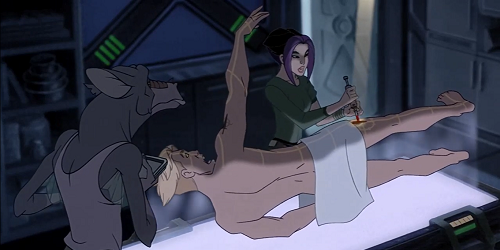 Ben: I think with that character, in terms of the script, she’s quite thinly-sketched. She obviously comes into it more as it goes on, but when you first meet her, you don’t really know where she’s coming from and all of that. But I was looking at it, and obviously Drew Barrymore is as adorable as she ever is in anything anyway, so she brings that nice softness to the vocals, definitely. The other thing with Akima is that she’s obviously got some Asian heritage, and so I also think you’re probably responding to the fact that she doesn’t look like Anastasia, or she doesn’t look like Thumbelina, do you know what I mean? Because the guys in it look like Don Bluth characters or, as I say, John Smiths, or something very kind of generic. Whereas Akima has actually got something pretty interesting going on in her design. I mean she’s one of the unique ones in there, with the purple hair, she’s totally different looking. And I wonder if anybody else was up for the voice, you know, like Ming Na or someone like that, someone with that kind of heritage. I don’t know if anybody knows about that, or whether it was always Drew Barrymore, but I would kind of put it down to that, Dacey, and I wonder if you’re reacting to that she doesn’t look like a generic Don Bluth character maybe.
Ben: I think with that character, in terms of the script, she’s quite thinly-sketched. She obviously comes into it more as it goes on, but when you first meet her, you don’t really know where she’s coming from and all of that. But I was looking at it, and obviously Drew Barrymore is as adorable as she ever is in anything anyway, so she brings that nice softness to the vocals, definitely. The other thing with Akima is that she’s obviously got some Asian heritage, and so I also think you’re probably responding to the fact that she doesn’t look like Anastasia, or she doesn’t look like Thumbelina, do you know what I mean? Because the guys in it look like Don Bluth characters or, as I say, John Smiths, or something very kind of generic. Whereas Akima has actually got something pretty interesting going on in her design. I mean she’s one of the unique ones in there, with the purple hair, she’s totally different looking. And I wonder if anybody else was up for the voice, you know, like Ming Na or someone like that, someone with that kind of heritage. I don’t know if anybody knows about that, or whether it was always Drew Barrymore, but I would kind of put it down to that, Dacey, and I wonder if you’re reacting to that she doesn’t look like a generic Don Bluth character maybe.
Dan: Yeah I would agree with that assessment from my end. She definitely looks very different from the fact that they gave her Asian features. I also noticed that maybe because of that they held back on using the rotoscoping as much on her compared to the other characters? I think the only time they may have used rotoscoping for her was during an early sequence when Pullman’s character was trying to bring Cale on board The Venture, and the Drej were coming to the mining site, and there was this running sequence that didn’t look as smooth.
Ben: Is that the shot with the moving camera?
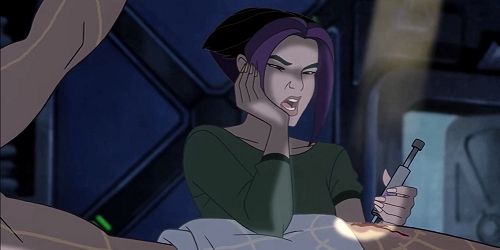 Dan: Yeah. That was one of those things where, every now and then, whenever they did the pan inside The Valkyrie and they tried to get the traditionally drawn characters to move as well, it just didn’t sync up quite right. At least that’s how I saw it.
Dan: Yeah. That was one of those things where, every now and then, whenever they did the pan inside The Valkyrie and they tried to get the traditionally drawn characters to move as well, it just didn’t sync up quite right. At least that’s how I saw it.
Ben: I’d go with that and, also, she’s got Princess Leia’s line as well. “Should I get out and push?” It’s not verbatim, but I couldn’t believe they ripped that off so blatantly!
Dacey: I’m not sure if it comes from a direction standpoint, or the character animation, or what; it just seems they are able to do more with her than the other human characters in the movie. For instance, towards the beginning where Akima is operating on Cale, he’s literally hovering naked right next to her, and at one point she actually puts her elbow down on him — again, he is naked there — and she’s leaning down on him bored, like “I can’t believe we went through all of that and nearly got ourselves killed just to save the window washer”. I mean that’s a great bit of animation that’s also a great character moment for her. I feel like they don’t give Cale as much in that regard, and even later on, at the risk of sounding pervy, when she’s briefly naked when Cale catches her in the shower, she has this very — again, I’m using the word “soft” when that may or may not be the right word — she just has this very pleasant blush on her that makes her seem very human, and very warm, in contrast to Cale, where it might be his design features that keep him from fully accomplishing that level of animation, at least until the end of the movie. Of course it’s also worth noting that Cale is supposed to be going through this character arc where he goes from “hard edged” to full-on soldier for the human cause.
Ben: Yeah. Good point.
 James: Can we talk about Drew Barrymore’s performance? It sounded like she was phoning it in almost the entire movie. I mean, she didn’t feel too much like she was experiencing the same emotions as the rest of the cast. They seemed like they’re actually at the studio, with the director coaching them on what they want from their character, but Barrymore literally sounds like she’s at home on her couch reading these lines without any context. It was just like, almost lieterally, she had a really good phone connection, but she’s just sitting at home doing it. I love Drew in just about everything else she does, but this was one of the worst animated voice performances I’ve seen.
James: Can we talk about Drew Barrymore’s performance? It sounded like she was phoning it in almost the entire movie. I mean, she didn’t feel too much like she was experiencing the same emotions as the rest of the cast. They seemed like they’re actually at the studio, with the director coaching them on what they want from their character, but Barrymore literally sounds like she’s at home on her couch reading these lines without any context. It was just like, almost lieterally, she had a really good phone connection, but she’s just sitting at home doing it. I love Drew in just about everything else she does, but this was one of the worst animated voice performances I’ve seen.
Dan: Yeah, I did get that sense too, especially when we’re also matching her up against other voice acting going that’s actually really good. I mean Nathan Lane, I thought, was the big standout, because it was totally unlike Nathan Lane when you hear him voicing Preed. Just hearing him and how his performance is, it’s very unique, and very intense at times too. And I actually liked Janeane Garofalo also, as Stith, because, again, you do hear traces of her in there, but at the same time she’s actually trying to not sound like herself and to develop a different type of voice for this character. Whereas with Drew Barrymore, it’s Drew Barrymore.
Dacey: You hire Drew Barrymore to be Drew Barrymore, though, just as you hire Matt Damon to be Matt Damon. You want her to sound like Drew Barrymore, who was this big star — and Matt Damon, who was on the road to becoming a star — but you don’t hire them for them to throw their voices. Compare that to today, when you hire a big name with a distinctive voice, like Benedict Cumberbatch to play The Grinch, and then he puts on this almost unrecognizable accent. So I feel with Drew Barrymore, you hire her to be “her”, just as you hire Matt Damon to be Matt Damon.
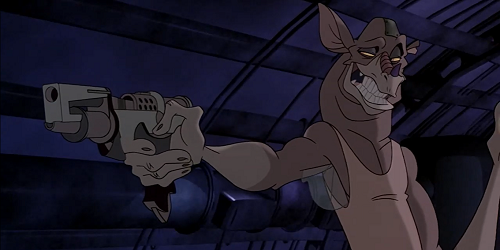 Rand: But that’s the thing, though, when you hire character actors, who know how to use their voice, it’s a whole different thing than hiring a movie star who’s largely known for their manner and their looks, like Drew and Matt, where someone like Nathan Lane has a great, distinctive voice and knows how to use it.
Rand: But that’s the thing, though, when you hire character actors, who know how to use their voice, it’s a whole different thing than hiring a movie star who’s largely known for their manner and their looks, like Drew and Matt, where someone like Nathan Lane has a great, distinctive voice and knows how to use it.
Ben: You know what I like about Nathan Lane in this, though, is that he pulls it back. You could’ve had like Marty Short in Treasure Planet, or he could go and just do Timon again, but he brings it back, and I totally forgot, until he came into it, that Nathan Lane was even in the movie! So that sort of tells you that he’s not overbearing, and I love that he was sarcastic in his way, but he acted — and that’s the thing — he just acted it well, because he’s Nathan Lane!
Dan: Yeah, it was quite a surprise for me, back when the film first came out, I’d kind of heard rumblings that Nathan was in the movie, and I was waiting to hear from him but it didn’t happen, and then the end credits happen, where they had the list of who voiced who, and I was like “That was Nathan Lane!?” That’s how good he was.
Dacey: I think the people who didn’t like him were the ones who were expecting Nathan Lane to be funny. They want him to be like he was in The Lion King. He’s still funny, but he’s a much, much darker character than he normally plays.
Ben: He was not Max Bialystock! (laughter) So what do we think of Gune and John Leguizamo, who’s obviously going for a Peter Lorre impression almost, and he reminded of the guy — who’s the one in Atlantis…?
Dacey: Mole. Played by Corey Burton.
 Ben: See, here’s the thing, to me, this is like an unofficial trilogy we have with Atlantis, and Treasure Planet, and Titan A.E. It’s like it forms this unofficial sci-fi-slash-quest trilogy, which all have a very similar kind of design. Obviously Treasure Planet is as elaborate as any Disney movie, but they almost have this kind of — correct me if I’m wrong — Alex Toth, that kind of look?
Ben: See, here’s the thing, to me, this is like an unofficial trilogy we have with Atlantis, and Treasure Planet, and Titan A.E. It’s like it forms this unofficial sci-fi-slash-quest trilogy, which all have a very similar kind of design. Obviously Treasure Planet is as elaborate as any Disney movie, but they almost have this kind of — correct me if I’m wrong — Alex Toth, that kind of look?
Rand: I don’t know if I particularly saw a Toth influence, because Atlantis was largely designed by Mike Mignola, the comic artist behind Hellboy. But Titan A.E. I thought was a great-looking film. Very good animation, and the CGI elements blended pretty well.
Ben: But they have that kind of 60s Johnny Quest-type, almost comic book animation of the 60s, which is interesting when you say about how you thought the CGI and the traditional were blended well, because that was something that actually really stood out for me on this viewing. I noticed that a lot of the CGI was done on twos to try and help it blend more, but then that just made the CGI look a bit more staccato to me. It’s weird because you have these 60s action cartoon designs, with quite a layered look on the CGI, in a film that ultimately feels really 80s…? It’s quite a mish-mash of not only different styles and designs, but just the feel it it, the tone of it.
Rand: Well I thought that the drawn animation and the CGI was probably better brought together better in Titan A.E. than it was in some of DreamWorks Animation’s “tradigital” films. Something like Sinbad where you see a much starker contrast between the hand drawn and the CGI. I thought Titan A.E. did that really nicely.
Dan: That was very apparent in Sinbad when you had the sequence when they were being chased by the giant snowbird. That clearly looked like traditional characters against CG that didn’t necessarily blend well together.
Rand: Yeah, there it was like the beast flew in from a whole other movie or something!
 Ben: But did you not notice the staccato thing on the CGI though? Especially at the beginning where Cale is in the spacesuit and he’s walking? And the boots are kind of going ‘da, da, da, da, da’ like this, you know, it’s quite… I don’t know, maybe because I’m looking at it again so closely, I found it really looked obvious to me.
Ben: But did you not notice the staccato thing on the CGI though? Especially at the beginning where Cale is in the spacesuit and he’s walking? And the boots are kind of going ‘da, da, da, da, da’ like this, you know, it’s quite… I don’t know, maybe because I’m looking at it again so closely, I found it really looked obvious to me.
Dan: Possibly. I don’t think I was able to catch that.
Rand: I think where I saw the biggest disconnect was when Cale was in his space suit, and you see the space suit flying up and down, and his head was kind of bouncing up and down separately. That didn’t blend as well.
Ben: We also mentioned earlier the rock music. How do we feel about that now?
Dan: Boy does that age the film! It ages it so badly.
Ben: Yeah, I remember at the time it was quite cool, it was quite, “Well, this is different”, you know. But now it feels like — well, obviously it was — just there to pull in the kids at the time.
Dan: Yeah, even though Fox had thrown in the towel on the film, it was like “Well, we gotta make some kind of money off this. So let’s throw in Lit on the soundtrack, let’s throw in Powerman 5000! I’m sure this will bring people in!”
Rand: But I think that’s one other thing that makes the film feel like an older film, because it makes it reminds you so much of how Heavy Metal uses a rock soundtrack as well.
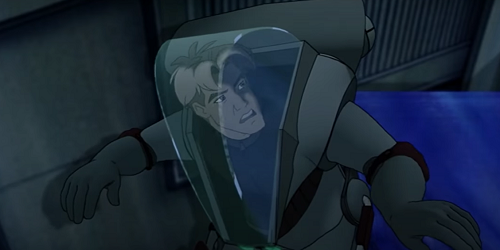 Dacey: I have no problem with movies feeling like products of their time. I know Bluth was worried about the soundtrack potentially dating the movie, but for me it’s like not an issue at all. Yes, the songs might sound like they came from the year 2000, but they’re also largely good, and they work for the film’s different tone. Titan A.E. is also trying to sound like a product of the future, and all sci-fi films almost by default, because of what has come before — Flash Gordon, some of the Star Trek films, even Star Wars itself — usually have an 80s influence. I probably said what I was trying to say in a far more complicated matter than I intended!
Dacey: I have no problem with movies feeling like products of their time. I know Bluth was worried about the soundtrack potentially dating the movie, but for me it’s like not an issue at all. Yes, the songs might sound like they came from the year 2000, but they’re also largely good, and they work for the film’s different tone. Titan A.E. is also trying to sound like a product of the future, and all sci-fi films almost by default, because of what has come before — Flash Gordon, some of the Star Trek films, even Star Wars itself — usually have an 80s influence. I probably said what I was trying to say in a far more complicated matter than I intended!
Ben: No, I gotcha! I have no problem with a film feeling dated as to when it was made. I think we’re just making the observation that it doesn’t feel as timeless as say — well, Aladdin has some stuff that dates it, and Beauty And The Beast — but they’re still very timeless films. Whereas when you watch this, it’s not that dating it is a bad thing, but you can literally tell when it was made, like in this case the late 90s or early 2000s.
James: I actually enjoyed a lot of the songs, though I had an issue with how they were used in the context of the film, like the first time we see Cale after being forced off his home planet, the song tells us he’s a “cosmic castaway”. And then being chased by the bad guys? The lyrics being sung as he runs say “I gotta get outta here”. Right after they finally create a new Earth? “If you’re looking for a new Earth just open up your eyes”. They were almost always a little too on the nose!
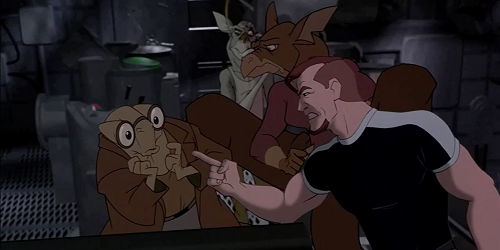 Dan: The other thing that kind of distracted me about the music was they were trying to jam as much of the soundtrack songs as they could in there, leaving very little room for Graeme Revell’s music score. There’s only like five or ten minutes’ worth of his music score in there in comparison.
Dan: The other thing that kind of distracted me about the music was they were trying to jam as much of the soundtrack songs as they could in there, leaving very little room for Graeme Revell’s music score. There’s only like five or ten minutes’ worth of his music score in there in comparison.
Ben: But he makes that score work! I found the ending really exciting, I really got pulled back into it. You’ve obviously got the space battle going on, but it wasn’t just a space battle: you’ve got everything in the Titan going on, and the chase, and trying to get the power couplings to work. I thought it was excellent; it was really well cut, it’s well staged and really nicely boarded out, but that’s all down to him and his score, along with Christopher Boyes’ sound design, which is just really fantastic. You know, how they pulled that together in post right near the end of production, and did that kind of soundtrack. Absolutely awesome.
Dacey: I’m sure you’re talking in particular about things like the ice crystal sequence in terms of the sound?
Dan: Oh yeah, definitely. Particularly in the chase, before they actually find the Titan, where there’s that great use of sound in order to enhance the whole cat and mouse notion of the sequence going on.
Ben: Building up the tension.
Dacey: Right, and there really wasn’t much stuff like that in animated movies of the time. That to me feels very much like something out of a live-action movie. Something like that is atypical for animated films.
Ben: Yeah, absolutely. Totally, agree. So what do we think of The Drej?
Dan: Well, after a while, I was thinking, I don’t recall my initial feelings about them when the film first came out, but looking at them with retrospective eyes, unfortunately, I’m looking at it and thinking…”ehh, fairly generic.”
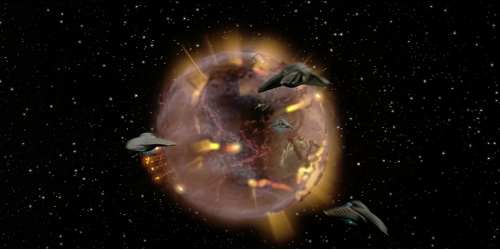 Ben: I like how they’re not really explained, though, and we don’t have a backstory where we see “The Drej have to leave their home world”, and get a whole backstory and all that. You know, it’s quite cool that they’re just these big blue bad guys, you know. And I like the look of them.
Ben: I like how they’re not really explained, though, and we don’t have a backstory where we see “The Drej have to leave their home world”, and get a whole backstory and all that. You know, it’s quite cool that they’re just these big blue bad guys, you know. And I like the look of them.
Dacey: They’re “okay to kill” then that way. For this kind of movie, Fox was probably wanting a being of pure evil that parents wouldn’t get too uncomfortable with seeing being killed. I think that’s one reason they’re aliens who don’t bleed when they get shot, they just kind of vaporize. I think it was also important to Fox — and maybe Bluth as well — to have an alien creature they could kill as much as they wanted without it becoming overly violent.
Rand: I thought they had quite a neat appearance. I think it was pretty unique compared to anything else you would see, certainly in live-action. These are creatures who could only exist in animation, or special effects, so I thought that was nicely done.
James: I thought the way the Drej technology “passed through” things was very cool and distinctive visually. But more importantly it was extremely clever from a story point of view, and gave the animators a lot of ways to show us something new and different, and allowed the writers to come up with situations where we as viewers didn’t know what to expect next.
Ben: They have a very cool look, and I also like how, in the commentary, they say how they went to great lengths to get this sort of male/female kind of voice that had this split timbre to it — and then Fox went and changed it to this alien language and dropped in subtitles, but I love the fact that it is an alien language with subtitles in an animated film of this kind. I just think that’s brilliant. That’s a brilliant move.
 Dacey: Yeah, Don Bluth, for whatever reason, was not happy about the subtitles being there, I don’t know why. Multiple times on the commentary he laments The Drej having subtitles. So that’s just something that, for whatever reason, peeved him.
Dacey: Yeah, Don Bluth, for whatever reason, was not happy about the subtitles being there, I don’t know why. Multiple times on the commentary he laments The Drej having subtitles. So that’s just something that, for whatever reason, peeved him.
Ben: But, I think it really works, because it kind of adds another layer to this film that it’s not a cartoon. You know, it’s actually got some parts of the movie where you have to read the screen! You know, “if you want to know what’s going on, read this sentence!”
Dacey: Then Atlantis comes out the following year and it uses a ton of subtitles!
Dan: To the point where there’s a bonus feature on the DVD which is a breakdown of the language so you can understand even better what it’s about!
Ben: Another thing I caught, just at the end of the commentary, was about Planet Bob, where they say they had such little time to render that last shot where it pulls back, and you can really see — again if you want to talk about dating a film — the ridges on the mountain that they’re standing on.
Dan: It’s like when they do the pan out, that’s a very clear indication of traditional characters standing on this fully CGI mountain.
Ben: Well, they’re CGI characters too, in that shot, and they look really good because that really blends well, but the weird thing is they’ve got these really good CGI versions of 2D characters on this really bad CGI mountain!
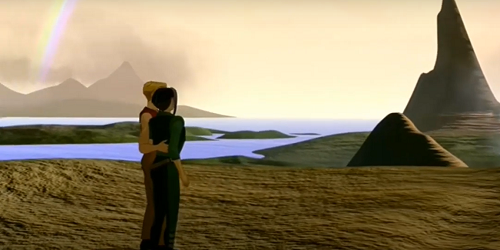 Rand: That was probably the worst shot in the film, and unfortunately it’s right at the end which leaves you with a bad impression.
Rand: That was probably the worst shot in the film, and unfortunately it’s right at the end which leaves you with a bad impression.
Ben: Yeah, unfortunately that’s the big payoff shot.
Dan: What a way to end the movie. “This is the new planet earth, badly rendered!”
Ben: And that’s the bad thing, because everybody walks out of the theater noticing that last shot! But I was going to say, when they call it “Planet Bob” at the end, I thought, “You know what, maybe that would’ve been a better title”. Go from Planet Ice to Planet Bob, because I think that’s one of the things that killed it in the marketing. “What the heck is a Titan A.E.?”, you know, and all the time they just had to keep explaining “Oh, it’s After Earth, After Earth”. And funnily enough the website, if you go to After-Earth-dot-com now, it points you to that awful Will Smith movie.
Dacey: Yeah, that terrible, TERRIBLE M. Night Shyamalan movie!
Ben: Exactly, and you know, “could you honestly dump on this film anymore?”, because first Fox gives up on it, it doesn’t do well, and then they let the website go to that other movie! This is not going to help it!
Dacey: I was recently re-watching Roger Ebert’s review with Richard Roeper from the time, and they both loved this film. But what’s ironic is that Richard Roeper expresses strong concerns about the title because he thinks that “with this title, people aren’t going to go”. Roger Ebert is a bit more optimistic, because he’s like, “well it sounds different enough that people might be interested”, but it’s interesting that we’re talking about that now because ultimately the movie does bomb horribly.
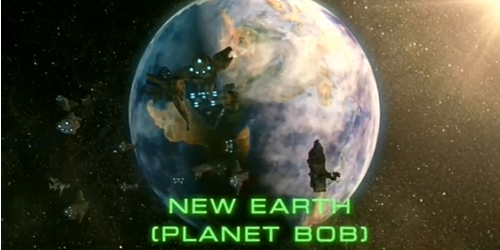 Ben: Do you think that “Planet Bob” would’ve been better?
Ben: Do you think that “Planet Bob” would’ve been better?
(Laughter from all)
Dacey: Well, they could’ve simply called it “After Earth” before there was actually a movie called After Earth, but maybe it was the family audience they were worried about. Maybe parents wouldn’t take their kids to a movie with that kind of title.
Rand: I think Planet Bob could’ve actually worked, but they would’ve had to market it entirely differently. One reason it bombed was because it looked so grown-up. It didn’t look like a kids film. Which is the reason I love it, but it didn’t really get that family market.
Ben: I think that’s a shame, because it made it, if anything, skew much more to the sci-fi audience who loves the likes of films with titles such as THX-1138, and Titan A.E.; it’s all got that kind of feel to it. I’m sure that had something to do with it not doing well: you know, if you can’t sell a film on its title — or you have to explain your title — then you’re in trouble before you even get the poster out. I’m sure that had something to do with families not going, because they’ve, of course, got this fairly serious sci-fi film with this serious sci-fi title, and then they try to market it on Nickelodeon to fourteen year olds. I mean I was 26/7/8 when I saw it, and I was bang on the perfect audience for it. I was just sitting there with my pal on this shoot, and we were awed by this film at the time. But we were that audience. For a wider audience, Titan A.E. is not the best title.
Dacey: We should also note, for the youngsters reading this, that at the time a PG rating was extremely rare for an animated film.
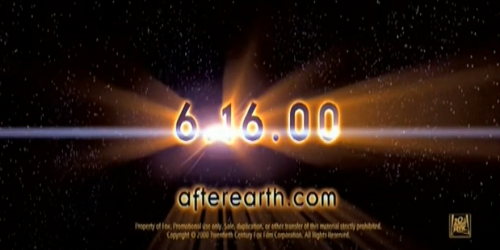 Dan: I think also, what was Titan A.E. up against at the time during that summer? Because, if I recall, the only other animation competition would’ve been The Emperor’s New Groove, but that didn’t come out until December. Whereas films that came out over the summer, the only ones that really pop into mind are Gladiator and X-Men.
Dan: I think also, what was Titan A.E. up against at the time during that summer? Because, if I recall, the only other animation competition would’ve been The Emperor’s New Groove, but that didn’t come out until December. Whereas films that came out over the summer, the only ones that really pop into mind are Gladiator and X-Men.
Dacey: I’m going to stop you there, because I can tell you right now what killed Titan A.E., and it was the movie that came out the following week: Chicken Run. Chicken Run opened one week after Titan A.E., and it killed it. It was a huge hit, whereas Titan A.E. was not.
Dan: There you go. But at the same time, though, when Titan did open, in its first weekend it opened at #5, so that was a bit concerning. Even before Chicken Run killed it dead on week two, it only opened at #5, so that was already pretty bad, and so I think that the timing of it was one of the things that ultimately hurt this film a lot. Because it’s coming out at a time when a lot of better mature films in live-action were starting to kick in, like X-Men.
Dacey: X-Men comes out a few weeks after, and I know that because they had a trading card promotion for Titan A.E., at least at my theater: if you went to Titan A.E. on opening weekend, you got free trading cards for the upcoming X-Men movie.
Dan: Wow. Who remembers that? Trading cards! I’m sure the younger readers who read this up are going to go “What’s that?”
Ben: “Trading cards? That’s like a baby’s toy!” (laughter) But I love the poster quote on the DVD that they were pushing heavily that says “This is the movie Star Wars fans have been waiting for!” And it’s kind of like…
Dan: Trying to poke fun at The Phantom Menace?
 Ben: Well, I think there’s a bit of that going on, but it’s also really setting yourself up for a fall. You know, you’ve got these fans, they’re either into Star Wars and animation, or they’re into Star Wars OR animation. And you know this is trying to straddle between the two worlds. I mean I don’t know how it played with hardcore Star Wars fans, but for them to make that kind of claim, you know, I don’t know how it actually played, because I’m into both.
Ben: Well, I think there’s a bit of that going on, but it’s also really setting yourself up for a fall. You know, you’ve got these fans, they’re either into Star Wars and animation, or they’re into Star Wars OR animation. And you know this is trying to straddle between the two worlds. I mean I don’t know how it played with hardcore Star Wars fans, but for them to make that kind of claim, you know, I don’t know how it actually played, because I’m into both.
Dacey: On the Star Wars note, I’m going to say that the only character in this movie who looks like he came from that universe is Nathan Lane’s Preed. He looks like something straight out of The Phantom Menace especially, which had come out only one year prior, in his design, and his characterization and everything. Otherwise I think Titan A.E. is much more anime-influenced if we want to use anything that’s comparable to it, or an 80s influence. I believe Don Bluth says multiple times on the commentary, or it might’ve been an interview with Gary Goldman I read, where they said they made an effort to make it as little like Star Wars as possible — and ironically they try to market it AS Star Wars.
Dan: Another indication that Fox gave up on this.
Rand: What’s interesting is that in the commentary Bluth actually notes that he didn’t know science-fiction very well at all, so he had no idea what he was riffing on or what looked too derivative. So as I’m watching the film, as much as I enjoy it, I kept thinking “Well, there’s Star Trek II! There’s Battlestar Galactica!” But Bluth didn’t even know. He didn’t realize that he was doing that, or that that’s what the movie was doing.
Dan: That’s probably another case of scenes being taken away from his studio and being given to someone else, and they’re like “Oh! Let’s throw these in!” And Bluth wouldn’t have understood that.
Ben: No, exactly.
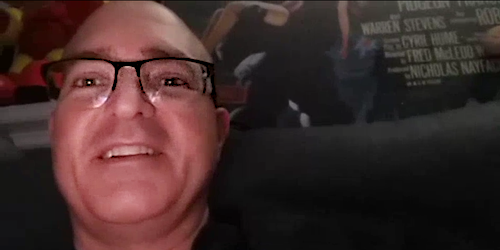 Rand: And as far as the film being successful or not successful at the time, it’s hard to remember now looking back twenty years ago, but this film was so unique. You know there was really not much of anything out there that looked anything like this, as far as a hardcore sci-fi animated film. The closest at the time that you could think of was The Black Cauldron.
Rand: And as far as the film being successful or not successful at the time, it’s hard to remember now looking back twenty years ago, but this film was so unique. You know there was really not much of anything out there that looked anything like this, as far as a hardcore sci-fi animated film. The closest at the time that you could think of was The Black Cauldron.
Ben: Oh no, wait, there’s one closer than that, Randall… Same year as Black Cauldron, I think. Anybody? Anybody?
Everyone else: Uhhh…
Ben: I always think that Bill Pullman’s character, Wild Joe Korso, feels like he’s been pulled completely out of this film. (pauses to give everyone a bit more time to guess) Nobody remembers…Starchaser??
Rand: Oh, yeah!
Dacey: I’ve never watched that.
Rand: You’re absolutely right: who remembers Starchaser?
Ben: The Legend Of Orin! This is how much I remember it. Ready? (starts thumping out and singing the theme music!)
Dacey: I’ll need to check that out.
Ben: Starchaser I think is — I did a review for AV years ago, my review is on the site somewhere — and that really is an animated Star Wars. It really is literally the same story as Star Wars done in this slightly Filmation style, but really quite good. And it was released in 3D back in the day, and it was quite a big deal at the time. If you’re such a big fan of Titan A.E. as I know you are, then you should absolutely check out Starchaser. It’s like the mid-80s version of what Titan A.E. was. It’s a pretty good little film, and it’s got a fantastically fun score.
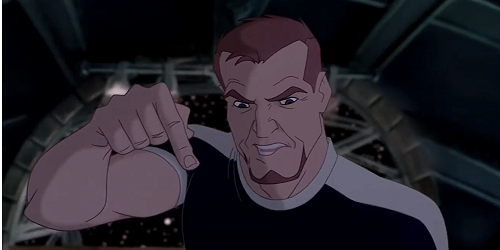 Dacey: Similar movies aside, how do we think Titan A.E. compares to Don Bluth’s other movies?
Dacey: Similar movies aside, how do we think Titan A.E. compares to Don Bluth’s other movies?
Ben: Like I said at the start, this is kind of like “Non Bluth”. It really is obviously, totally different. I think there are a lot of similiarities, oddly enough, to Anastasia, which I always felt was also very different to his previous films. You’ve basically got three tiers of Don Bluth, you know, where you’ve got the really high quality stuff of NIMH, maybe The Land Before Time, and An American Tail. Then everything goes kaput for ten years, where he’s really making almost direct-to-video type stuff, and pale imitations of other films, and then he suddenly gets this Fox deal, and Anastasia is much more Disney than anything else he did, really, which is what they were buying, but with a different edge to it, quite a serious, kind of acerbic edge, and I think that carries over into Titan as well. So for me he’s a filmmaker with three distinctly different creative time periods.
Dacey: I think following up on that, I get what you’re saying, because if you re-watch Anastasia, many people may be surprised by how “grown-up” it feels in a lot of ways. There are romantic comedy aspects in there, which weren’t in Disney movies at the time, there’s much more intense — well I’m not going to say “much” more intense because Disney had just done The Hunchback Of Notre Dame — but there are some much more intense “horror” elements.
Ben: Well, don’t forget Disney hanged their villain in Tarzan.
Dacey: Oh yes. Okay, there’s no way Tarzan would get a G rating today!
Dan: No, it wouldn’t. It’s funny, though, with Anastasia: last year the tour of the stage musical came to town and we got to see it. While I haven’t watched the animated film more recently to better compare, I remember thinking just watching the stage musical, it was very interesting how much of the animated film they were able to translate for the stage, how it seemingly easier it was for them to do that because of the themes and how mature it was compared to what we would be used to in animation back in the 90s.
 Granted, they completely threw out the supernatural elements, and decided to go with the original live-action Anastasia for the most part. It’s very interesting coming back to Anastasia and subsequently Titan A.E. that, technically speaking given he hasn’t really done anything of note since, this is kind of Bluth’s last hurrah in the field, so he goes out with a real big punch of mature and not necessarily kids-type movies that you would not have expected. Not just necessarily just in comparison to other films, but not necessarily from him either.
Granted, they completely threw out the supernatural elements, and decided to go with the original live-action Anastasia for the most part. It’s very interesting coming back to Anastasia and subsequently Titan A.E. that, technically speaking given he hasn’t really done anything of note since, this is kind of Bluth’s last hurrah in the field, so he goes out with a real big punch of mature and not necessarily kids-type movies that you would not have expected. Not just necessarily just in comparison to other films, but not necessarily from him either.
Ben: Absolutely, definitely. I think Anastasia would work well on stage: I haven’t seen it but we’re supposed to get it in London — well, we were supposed to get it in London this year but I think that’s on hold now for some reason! But I think Anastasia would work well on the stage because essentially it is a live-action movie but they’ve just rendered it in animation. Whenever I watch Anastasia, the animated film, it’s very staged — I don’t mean stage in a physical “stagey” way, but the way it’s staged or blocked out is very live-action. It does go back to that thing where they shot it all live and then rotoscoped it, and you get that feel. And because it is human characters — apart from Bartok — I think that’s why it would work really well on the stage. I actually can’t wait to see it: I’ve heard the soundtrack, the Broadway recording, and I can imagine that working really well.
Dacey: I think it’s interesting that when we try to talk about these movies as Bluth movies, he was essentially a director-for-hire on both Anastasia and Titan A.E. — you know, with that weird Bartok movie sandwiched between them — but I’m trying to come up with aspects of these movies that feel distinctively like Don Bluth. In Anastasia, everything with Rasputin feels like pure Don Bluth in terms of its weirdness, in its grotesque nature, and its sort of screwball, almost operatic level of comedy. In Titan A.E. it’s much harder for me to find aspects like that, outside of one moment — which actually feels kind of nasty — where they shoot that cook character, and he just explodes! Like that feels like something out of Don Bluth’s demented state of mind coming on screen full force. But aside from that, there aren’t many moments in Titan A.E. that come across to me as distinctly Bluth in nature, compared to NIMH or All Dogs Go To Heaven.
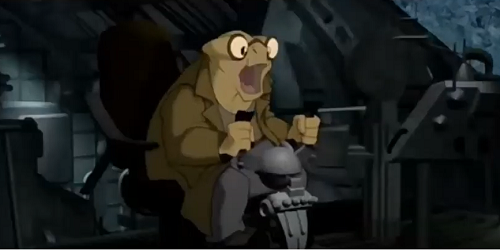 Rand: The only times where I really felt like I was watching a Don Bluth film was in the minor business, like where a character on the side of the screen would pick up something and fumble with it, or something like that. It was the smaller bits that seem more Bluth to me than the bigger action stuff.
Rand: The only times where I really felt like I was watching a Don Bluth film was in the minor business, like where a character on the side of the screen would pick up something and fumble with it, or something like that. It was the smaller bits that seem more Bluth to me than the bigger action stuff.
Ben: But definitely Gune is one of those kinds of characters. In fact, every now and then whenever I see the film, I kind of wish Gune wasn’t in it, because he’s just this weird character that doesn’t belong in this otherwise serious sci-fi film. You know, everybody loves him because he’s the funny cartoon, and he’s the comedy character with a couple of funny lines, but at the same time what is he bringing to this film other than a slight hint of 20,000 Leagues-era Peter Lorre to it?
Rand: Well, basically, that’s the Don Bluth character that inserts itself into the film.
Ben: Yeah, exactly.
Dan: I will say that for whatever reason at the time of the film’s release, the bat-like alien creatures on the planet that’s mostly water and hydrogen trees came off as rather Bluth to me. At the very least, they echoed how the pterodactyls were designed in The Land Before Time. And then you look over here, and they’re trying to infuse that with turning their wings into these long coats. So to me that had a Bluth type of appearance to it.
 Dacey: There’s a great touch that’s not made very explicit in the movie, at the beginning before earth is destroyed and everyone is being evacuated, where Cale’s father gives him to this alien character, who I can’t name right now, but he’s this alien who’s going to raise Cale from here on. And later on when we meet him, again this is never explicitly stated, I don’t think, but that character has gone blind. I think that’s such a great little touch that they don’t make a huge deal about, outside of one little line where Cale says “Wait until you see these guys” and he responds with “Fat chance of that happening”, or words to that extent. It’s great that the audience is able to work with this detail on their own. How did he become blind? Maybe the earth’s explosion blinded his vision when it happened, I don’t know. Little touches like that are something I very much like in these sorts of movies, and the sort of choice I believe Bluth made here.
Dacey: There’s a great touch that’s not made very explicit in the movie, at the beginning before earth is destroyed and everyone is being evacuated, where Cale’s father gives him to this alien character, who I can’t name right now, but he’s this alien who’s going to raise Cale from here on. And later on when we meet him, again this is never explicitly stated, I don’t think, but that character has gone blind. I think that’s such a great little touch that they don’t make a huge deal about, outside of one little line where Cale says “Wait until you see these guys” and he responds with “Fat chance of that happening”, or words to that extent. It’s great that the audience is able to work with this detail on their own. How did he become blind? Maybe the earth’s explosion blinded his vision when it happened, I don’t know. Little touches like that are something I very much like in these sorts of movies, and the sort of choice I believe Bluth made here.
James: I mentioned before that I hadn’t really seen many Bluth films.
Ben: So you’ve got an interesting perspective, then, because you can come to it fresh without all that baggage.
James: Well it’s not very Bluthy you said anyway…?
Dacey: Which Bluth films have you seen?
James: Oh, gosh. Let’s see… I haven’t seen Anastasia.
(Ben mocks an outraged scream)
Dacey (laughing): Okay, we gotta work on that! That’s nuts!
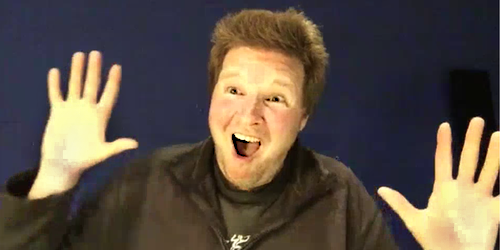 (Ben storms off in mock outrage)
(Ben storms off in mock outrage)
Dan (also laughing): Ben’s gone, Ben’s gone!
Dacey: I will mail James a copy if I have to.
Ben: I’m going to go and get it. Try to squeeze it down this microphone!
Dacey: Have you seen any of his other films other than Titan A.E.?
James: Well, let’s see…
Ben: You have seen NIMH, right?
James (pause): No.
(Ben mock storms out again!)
Dacey: (laughing)
Dan (laughing): Ben is going to the store; he’s buying those Blu-rays, and going to send them to you!
James: Maybe I should pull up a list.
Ben: Hang on, hang on! Because this is getting really, really bad when he tells us he hasn’t seen NIMH — but he HAS seen Rock-A-Doodle! (laughter from all) He’s going to tell us that he’s seen Rock-A-Doodle…and A Troll In Central Park. (laughter continues) By the way, over here in Europe — talk about a bad title — we got that film as…drum roll…Stanley’s Magic Garden!
Dacey (bursts out laughing): Maybe a more accurate title. I don’t know.
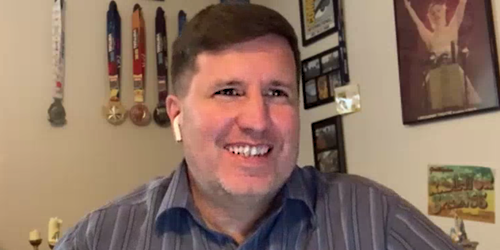 James: Looking at this list, I’ve seen American Tail. I think that’s it!
James: Looking at this list, I’ve seen American Tail. I think that’s it!
Dacey: You haven’t seen The Land Before Time?
James: None of them.
Dan: Oh, man.
Ben: Well only the first one counts, but you’re missing a chunk there.
Dacey: I’ve watched all of them, every single one of them. I have watched every Bluth movie, but I have not played Dragon’s Lair.
Dan: Yeah, I’ve managed to miss out on that period after All Dogs Go To Heaven. Pretty much haven’t seen the films between All Dogs and Anastasia.
Ben: I’m going to say that I’ve seen all of them. I don’t own all of them, but I’ve seen all of them. Not all in the theater: sometimes I just waited for them to turn up on TV, though I only saw Pebble And The Penguin when it hit DVD about ten years ago, because that one passed us by over here.
Dan: That was barely in theaters over here!
Ben: But Rock-A-Doodle? I went to see that, and I’ve got a weird soft spot for Rock-A-Doodle and yet it’s such a mess of a film. But there is some weird thing that keeps pulling me back to that one, I don’t know what it is.
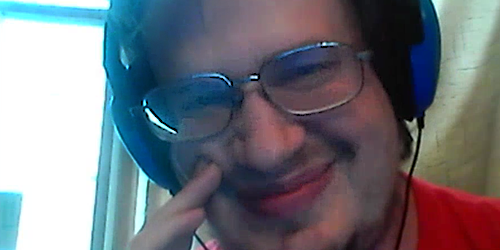 Dacey: I think there’s just some sort of Bluth element to that film that feels like Don Bluth got completely wasted and then made an animated movie. The Christopher Plummer character is just a pure Don Bluth villain both in terms of design and his personality. Even though the story doesn’t make a lick of sense.
Dacey: I think there’s just some sort of Bluth element to that film that feels like Don Bluth got completely wasted and then made an animated movie. The Christopher Plummer character is just a pure Don Bluth villain both in terms of design and his personality. Even though the story doesn’t make a lick of sense.
Ben: I would be really interested to know — because he was at Disney when they were doing that in the 60s — what was maybe lifted from the Chanticleer film they were working on at the time. But I remember, when it came out, that I was intrigued Bluth was basically doing the Chanticleer story, and then of course Rock-A-Doodle waivers a lot from the story, but at the same time, it kind of still is that story. I’ve always been interested in how much of the 60s film was in there, which obviously Disney kind of parlayed into Robin Hood at the time, and became the whole design concept behind Robin Hood‘s animal cast. But All Dogs is the film where I thought that was the start of the slide for Don Bluth.
Dan: It was odd. It was so odd. Especially when you look at his previous films, you’re sitting there thinking “Where is this going?”
Ben: But you know again why the Fox movies work is because he didn’t have total control. And he didn’t have total control — well, I guess he kind of did on NIMH, but that’s based on a strong book — and An American Tail, that was Spielberg and his team pushing that through, and the same with The Land Before Time. But then he gets control at Sullivan-Bluth and — have you guys seen Banjo The Woodpile Cat? That is a really charming little film, but ultimately derivative of other stuff; Aristocats especially, and a bit of One Hundred And One Dalmatians in there.
 Dacey: Okay, that’s one Bluth film I haven’t seen then! I have seen The Small One, of course.
Dacey: Okay, that’s one Bluth film I haven’t seen then! I have seen The Small One, of course.
Ben: Awwwww, Small One! Every Christmas we run a double bill of Small One and Muppet Christmas Carol, and I blubber and blubber through Small One. Twice, in the Friendly Face song, and the end when he waves goodbye to Joseph as he leads Small One away, that’s the water works flowing everywhere! I don’t mind admitting it: it gets me every single time. And Pete’s Dragon, of course, which I adore for what it is. But with Banjo, the thing you realize is when he’s got total control, he’s not really a great storyteller. When there’s a collaborator, like with Fox and with the Amblin films, or NIMH where he’s got a good book, he does a pretty good job, and he’s obviously a strong director, but he’s not great at stories. And the films where he went off on his own — the whole Sullivan-Bluth Studios period — you know, I think James can feel vindicated in his way that he has not seen those films.
Dan: When I was living in Pensylvania, Bluth and Goldman held a two day seminar over the weekend near one of the cities I lived in — I believe it was the year after Titan A.E. — and I went to it. A lot of the time a bunch of us asked random questions, and they were more than happy to answer, and I asked about John Pomeroy, because originally it was a three-man team of Bluth, Goldman and Pomeroy. Then Pomeroy decided he would go back to Disney — oddly enough, he would be the supervising animator of John Smith — but I asked about what happened with John, and Goldman was the one who answered, presumably because he was the more diplomatic of the two. According to him, as he explained it, John felt that he wasn’t getting a sense of satisfaction in that it didn’t seem his work was getting as widely seen or as widely appreciated as he had been hoping after the original split, which is why he ended up going back to Disney. But with what you just said, I think that just adds to the whole thing — probably sprinkling a bit more on it — as to why Pomeroy left. Even though he was the lead character animator on all of Bluth’s films, he was like, “I’m just kind of drawing the same thing here”, and he wanted to do something different and figured Disney would give him a better shot at that.
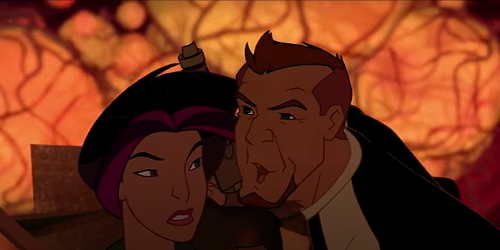 Ben: And I think that a weak spot of Bluth’s films is how he did used to like to design all the characters. But then every character ends up looking the same, basically. They have those kind of eyes, and the same kind of mouths, and it’s a shame really he didn’t delegate more. He had talented people working for him.
Ben: And I think that a weak spot of Bluth’s films is how he did used to like to design all the characters. But then every character ends up looking the same, basically. They have those kind of eyes, and the same kind of mouths, and it’s a shame really he didn’t delegate more. He had talented people working for him.
Dan: Like what you said earlier — particularly with the male characters — you could see Don Bluth characterizations on those characters, and I feel like that’s been something applied to nearly all of his human characters throughout his career. Each one had the same facial design. I could almost see Dirk the Daring in Cale!
Dacey: I’m going to throw Vladimir from Anastasia out there, because he looks different. The Kelsey Grammer character.
Ben: Oh, yeah, yeah. Although, who does he remind me of? He’s the same as…someone in Rock-A-Doodle, but I can’t say who.
Dacey: Were there even humans in Rock-A-Doodle?
Ben: Well not necessarily human, but just the geometry of the eyes and the shape… Okay, the toad. One of the toads in Thumbelina, and I know that sounds weird, but when you look at the mouths and the lips, you can see Vladimir definitely. He’s got that same kind of shape if not exactly the same design. There’s definitely a Bluthism when you see his designs.
 Dan (showing off a packet with several Bluth sketches on it): This is from the packet we got at the seminar, and you can see that a lot of these are pretty much right on the button. He’s trying to explain like this is a characterization for mean, and this is a characterization for courageous, but you can kind of get a sense that a lot of the designs for the design of the characters are reused or at least elements are retained throughout as they progress.
Dan (showing off a packet with several Bluth sketches on it): This is from the packet we got at the seminar, and you can see that a lot of these are pretty much right on the button. He’s trying to explain like this is a characterization for mean, and this is a characterization for courageous, but you can kind of get a sense that a lot of the designs for the design of the characters are reused or at least elements are retained throughout as they progress.
Ben: But that’s the problem when you have the same guy doing every design. You don’t get that, for want of a better word, diversity. And that’s the thing, because he doesn’t delegate in that way. You know, all the eyes look the same, all the mouths look the same. Even the way some of them move, you know. The dad at the beginning of Titan — just to bring it back to that film that we might remember! — when he’s explaining to Cale that, “I gotta go away, and you gotta go with this guy”, just the movement is very much like the dad in The Small One. You know, he’s got that same angular way, and everybody slightly overacts because they have to impart all this important stuff. There’s definitely the Bluth style in there not just in how they look, but how they act as well, the way he directs them to do the movement.
Dacey: So did Don Bluth design every major character in every one of his films?
Ben: Pretty much. From what I understand, he designs all the characters, and I think he storyboards a lot if not most of the film as well.
Dacey: So it’s not like a Disney film where, like on something like The Hunchback Of Notre Dame, they would give Quasimodo to one animator, Esmeralda to another animator, Frollo to someone else, etc.
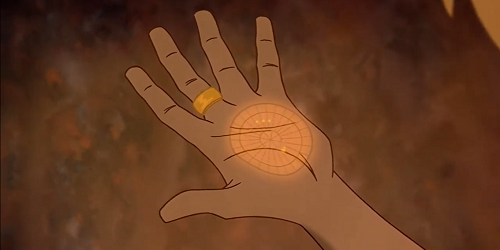 Ben: No, not like that. He designs everything from the ground up. Which, in some ways, gives him a genuine validity to being described as an animation auteur. That’s a very rare thing in animation, since it’s such a collaborative medium, but one can always certainly tell immediately when it’s a Don Bluth production. They’re not always successful films, creatively or commercially, but Bluth is always protective of his process and maybe believes that he has this massive legacy that is perhaps a bit more golden than it is. Then again, making just one film is an incredible achievement, let alone a bunch of them, and especially to the extremes he’s worked both as an independent — which, when he left Disney, was a brave time, a crazy time, to venture out on your own — and then as part of a studio system for Spielberg and Fox, with all the multiple approvals that have to be agreed by everyone. Given those pressures, it’s a minor miracle Titan A.E. turned out as well as it did, unfortunately falling prey to a studio that gave up on the film and that whole style of animation, really, during production. But then the whole business was going the same way — we touched on it earlier, but Final Fantasy was exactly a year away and proved that the same kind of film couldn’t do any better just because it was CGI. Titan, I don’t think, deserved to share that same kind of fate, and whatever we’ve brought up in this discussion, I think we’d all agree that, along with Atlantis and Treasure Planet, it shares a uniqueness for being what one would expect to be a live-action concept, but told through that short-lived but wonderfully lush “tradigital” medium. If there’s one thing missing in the films we have today, it’s a freshness and difference between each one. And Titan A.E. is certainly worth celebrating for that difference!
Ben: No, not like that. He designs everything from the ground up. Which, in some ways, gives him a genuine validity to being described as an animation auteur. That’s a very rare thing in animation, since it’s such a collaborative medium, but one can always certainly tell immediately when it’s a Don Bluth production. They’re not always successful films, creatively or commercially, but Bluth is always protective of his process and maybe believes that he has this massive legacy that is perhaps a bit more golden than it is. Then again, making just one film is an incredible achievement, let alone a bunch of them, and especially to the extremes he’s worked both as an independent — which, when he left Disney, was a brave time, a crazy time, to venture out on your own — and then as part of a studio system for Spielberg and Fox, with all the multiple approvals that have to be agreed by everyone. Given those pressures, it’s a minor miracle Titan A.E. turned out as well as it did, unfortunately falling prey to a studio that gave up on the film and that whole style of animation, really, during production. But then the whole business was going the same way — we touched on it earlier, but Final Fantasy was exactly a year away and proved that the same kind of film couldn’t do any better just because it was CGI. Titan, I don’t think, deserved to share that same kind of fate, and whatever we’ve brought up in this discussion, I think we’d all agree that, along with Atlantis and Treasure Planet, it shares a uniqueness for being what one would expect to be a live-action concept, but told through that short-lived but wonderfully lush “tradigital” medium. If there’s one thing missing in the films we have today, it’s a freshness and difference between each one. And Titan A.E. is certainly worth celebrating for that difference!

Coming Soon: Our next Flashback isn’t just any old poultry offering: it was the surprise animated hit of its year!



Or am I thinking of something else?
(And yes, it's pretty clear that Don Bluth getting the picture was just the momentary studio elation of "We got one, we got
The director of Planet Ice
There was also some interesting visual development being done toward realizing Planet Ice
I think part of the problem was that Planet Ice
I did later get to work with a bunch of those Fox Animation design & layout artists on The Barnyard
I am thankful, actually, that Shrek came out when it did, because I love the way those films look. They're very unique as far as their design is concerned, and I think Fiona is a good example of how to do a "realistic" human while still managing to make her animated. Had it come out even a few years later, there's a very good chance she would've looked like Susan in Monsters Vs. Aliens, which is fine, but everyone in Shrek probably would've looked different if the film had come out in a post-Incredibles world (similarly, after Tangled, Disney basically found the style they would use for all their future movies).
Oddly enough, as things turned out, the first "cartoony" CGI movie we got in theaters was Jimmy Neutron: Boy Genius. Shame we're never going to get that "The Art of Titan A.E." collectors book so some of this artwork could be seen by the general public now.
----------------------
Nice to see StarChaser: Legend of Orin
{ CLICK HERE TO VIEW THIS VIDEO }
----------------------
As for the Titan A.E.
When The Fifth Element
But a few years later, after the release of the 'special editions' and a couple of the prequels .. that Fifth Element
----------------------
One of the characters I found really intriguing in the early portion of the Titan A.E.
I wasn't too fond of Gune, either. But Stith was kinda awesome.
Terrific read!
Also, The Small One has apparently been given a full restoration for Disney+. I still don't have the service, but from what I've heard, it looks stunning.
I could say I'll jump on FII, but someone just mentioned a restored Small One! This is an annual waterworks fest for me and my sister, so it'll be cool to see this looking and sounding better than the VHS and DVD we used to run. My hope is that it's at 1.66:1 and not the 1.33 open matte of previous releases, as it'll be nice to see the correct framing (that I usually approximate by cropping top and bottom of the open matte). I hope so, or otherwise that's just a little bit lazy, given they've done a restoration.
Now I'm really hoping for a 4K disc, that won't come, which presents The Small One and The Muppet Christmas Carol as the double feature we try to run each year! They could toss in an un-DNR'd Mickey's Carol too to make it a perfect Christmas disc!
Brave IIFrozen II already, now that it's free-with-subscription.I know you may have apprehensions too, but it won't hurt you, which is a heck of a thing for a Frozen-loather like me to truthfully say in public.
Which is ironic, considering the one reason
It's a pre-NIMH, pre-Anastasia, pre-Land, pre-Titan DON BLUTH
A for dating Small One...isn't that all a little too obvious and low bar bashing for even you?